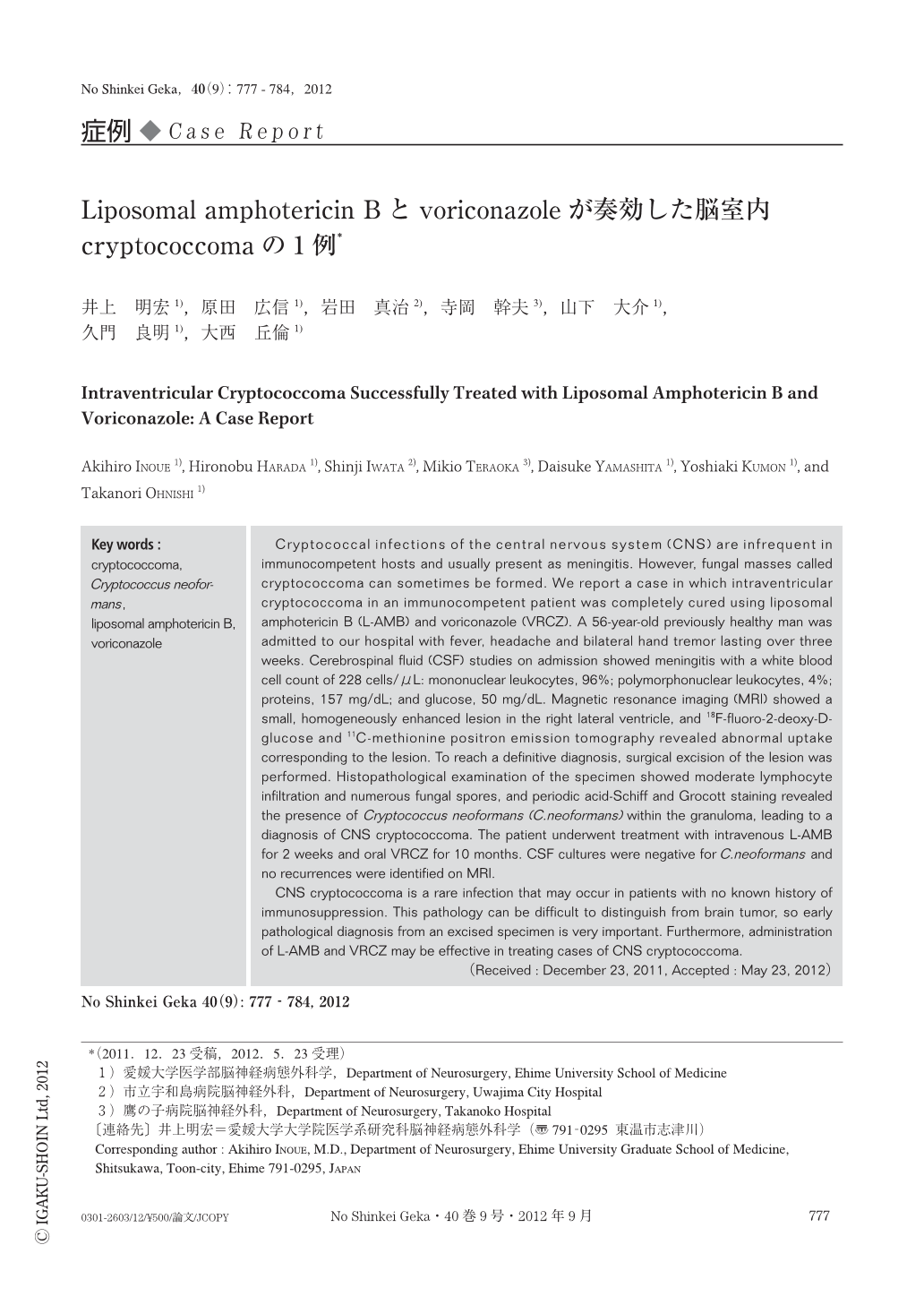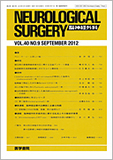Japanese
English
- 有料閲覧
- Abstract 文献概要
- 1ページ目 Look Inside
- 参考文献 Reference
Ⅰ.はじめに
真菌性中枢神経感染症であるクリプトコッカス脳髄膜炎は,一般的には免疫機能不全患者の日和見感染症として知られているが,ときに健常者にも発生することがある.また,病態が進行しcryptococcomaと呼ばれる脳実質内肉芽腫を形成することも報告されており,未治療では致死的となる場合も多く,迅速な診断,治療が必要な感染症である11,14,18).元来,クリプトコッカス脳髄膜炎の治療は,amphotericin B(AMPH-B)と5-flucytosine(5-FC)の併用投与が基本とされていたが4),薬剤毒性による腎障害などの問題もあり,最近ではliposomal amphotericin B(L-AMB)やvoriconazole(VRCZ)などの副作用が軽減された薬剤への関心が高まりつつある11,16).
L-AMBは,ポリエンマクロライド系の抗真菌薬であり,発熱や腎毒性などの副作用がAMPH-Bより少ない抗真菌薬として知られており,クリプトコッカス脳髄膜炎においても,腎機能低下が問題になるような症例において特に推奨されている11,14).また,トリアゾール系の抗真菌薬であるVRCZも高い抗真菌作用を有し,侵襲性アスペルギルス症を対象としたAMPH-Bとの比較試験では,有効性および安全性においてAMPH-Bより優れていることが報告されており6),本邦のクリプトコッカス脳髄膜炎の治療ガイドラインでも第二選択薬に位置づけられ,今後の効果が期待されている18).今回われわれは,非免疫機能不全患者の脳室内に発生したcryptococcomaの1症例を経験し,L-AMBおよびVRCZを使用することで良好な治療結果を得ることができたので報告する.
Cryptococcal infections of the central nervous system (CNS) are infrequent in immunocompetent hosts and usually present as meningitis. However, fungal masses called cryptococcoma can sometimes be formed. We report a case in which intraventricular cryptococcoma in an immunocompetent patient was completely cured using liposomal amphotericin B (L-AMB) and voriconazole (VRCZ). A 56-year-old previously healthy man was admitted to our hospital with fever, headache and bilateral hand tremor lasting over three weeks. Cerebrospinal fluid (CSF) studies on admission showed meningitis with a white blood cell count of 228 cells/μL: mononuclear leukocytes, 96%; polymorphonuclear leukocytes, 4%; proteins, 157 mg/dL; and glucose, 50 mg/dL. Magnetic resonance imaging (MRI) showed a small, homogeneously enhanced lesion in the right lateral ventricle, and 18F-fluoro-2-deoxy-D-glucose and 11C-methionine positron emission tomography revealed abnormal uptake corresponding to the lesion. To reach a definitive diagnosis, surgical excision of the lesion was performed. Histopathological examination of the specimen showed moderate lymphocyte infiltration and numerous fungal spores, and periodic acid-Schiff and Grocott staining revealed the presence of Cryptococcus neoformans (C.neoformans) within the granuloma, leading to a diagnosis of CNS cryptococcoma. The patient underwent treatment with intravenous L-AMB for 2 weeks and oral VRCZ for 10 months. CSF cultures were negative for C.neoformans and no recurrences were identified on MRI.
CNS cryptococcoma is a rare infection that may occur in patients with no known history of immunosuppression. This pathology can be difficult to distinguish from brain tumor, so early pathological diagnosis from an excised specimen is very important. Furthermore, administration of L-AMB and VRCZ may be effective in treating cases of CNS cryptococcoma.

Copyright © 2012, Igaku-Shoin Ltd. All rights reserved.


